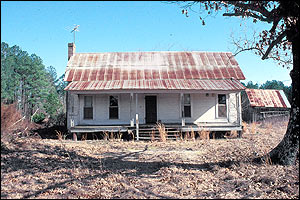Listed in Arkansas Register of Historic Places on 03/05/97
SUMMARY
The Ragsdale House is being nominated to the Arkansas Register of Historic Places under Criterion C for its depiction of the evolution of a vernacular farm house in rural Union County. The Ragsdale House was constructed as a simple, two-room house in 1898, evolved into a larger, Folk Victorian-style residence in 1903, and later lost those decorative elements due to deterioration and neglect. Unfortunately, the property is currently ineligible for inclusion in the National Register of Historic Places due to the loss of the Folk Victorian details, which are documented in a 1910 photograph of the house.
ELABORATION
The community of Shuler is located 14 miles west of El Dorado in Union County. Although settlement occurred in the early 19th century, by the time of the 1937 Shuler oil boom, the town was no more than a few abandoned frame houses.
According to family records, Joseph A. Ragsdale from Alabama, and his wife, Mary E. Sewell, had farmed in the general area north of Shuler in Union County since the 1850s. Around 1903, Ragsdale’s son, William Franklin Ragsdale, bought an adjacent forty-acre tract of land from his brother, John Robert Ragsdale. This tract of land had a two-pen dogtrot house which John Robert Ragsdale had built in 1898.
Joseph A. Ragsdale and his wife, Mary E. Sewell, farmed in the general area north of Shuler in Union County. In 1896, his son, William Franklin Ragsdale, and his wife, Hattie Sessoms Ragsdale, homesteaded a 42-acre tract of land adjacent to his father’s farm. According to family oral history, his father, Joseph A. Ragsdale, built the couple a two-pen dogtrot house in 1898.
Soon after they moved into the house, William F. Ragsdale and his wife, Hattie Sessoms Ragsdale, began to enliven the house with Folk Victorian decorations and construct additional rooms in order to accommodate their large family.
On this farm, the Ragsdale family raised cotton, corn, cane, and hogs in addition to a vegetable garden and fruit orchard. According to the current owner, one indication of the extent of the influence of the Ragsdale family is that the road now known as Midway Road was once known as Ragsdale Road.
After the death of William F. Ragsdale in 1926, the farm lands were decided among the three children. The daughter, Sadie, was given the house and the land immediately surrounding it. This change was not recorded until 1935, after J. G. Ragsdale had paid the mortgage on all of the farm and then recorded the ownership of the house to Sadie Ragsdale Primm.
Sadie Primm lived in the house until she died in 1969. According to her will, the house was to go to her son, William Cloys Primm , after the death of her husband, Ernest V. Primm. However, Ernest V. Primm outlived his son by fifteen years. Upon Ernest’s death in 1991, the house was given to his grandchildren (William’s children), Sherry Primm Brack and Reginald Primm. Ownership of the house and land was then acquired from Sherry and Reginald Primm by John G. Ragsdale, Jr. Ruth Sewell Primm, a second wife who survived Ernest V. Primm, lived in the house until she moved to a nursing home in 1994 and died in 1995. It is now owned by Mr. John G. Ragsdale, his fourth-generation grandson.
SIGNIFICANCE
The Ragsdale House was built as a simple, two-room house in 1898, although the exact nature of the plan and construction is not known. Around 1903, the house was expanded into a fashionable, L-shaped, Folk Victorian-style residence, and this appearance is documented by a c.1910 photograph. The majority of the Folk Victorian details, including the entire center gable, were later lost through deterioration and neglect. Although the property is ineligible for inclusion in the National Register of Historic Places in its current condition, the aforementioned lost Folk Victorian elements could easily be reconstructed based on the historic photograph. Nevertheless, the Ragsdale House is eligible for listing in the Arkansas Register of Historic Places under Criterion C for its depiction of a vernacular farm house in rural Union County.
BIBLIOGRAPHY
The Goodspeed Biographical and Historical Memoirs of Southeastern Arkansas. Chicago, Nashville, and St. Louis: The Goodspeed Publishing Co., 1889.
Information supplied by John G. Ragsdale.
Ragsdale, John G. As We Were in South Arkansas. Little Rock: August House Publishers, 1995, 68-86.
Sizemore, Jean. Ozark Vernacular Houses: A Study of Rural Homeplaces in the Arkansas Ozarks, 1830-1930. Fayetteville: University of Arkansas Press, 1994.
